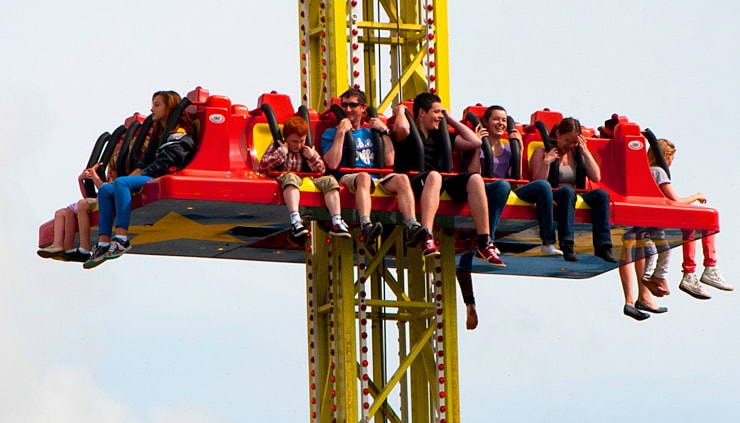Scottish Heavyweight Championships
Crieff Highland Gathering has, for many years, been the home of the Scottish Heavyweight Championships, the most prestigious heavyweight event in the Scottish Highland Games calendar.
Many of the competitors will also be competing for a second national title; the Scottish Native Heavyweight Championships.
This event will run concurrently with the open event, but entry is restricted to those competitors born and raised in Scotland, meaning the winner can lay claim to being the strongest Scotsman competing on the Highland Games circuit
Activities in the Scottish Heavyweight Event
Tossing the Caber
Contrary to popular belief the caber is not thrown for distance but for style. The games officials will set the caber on its end with the thickest portion in the air The athlete rests the caber against his shoulder and, clasping his arms around it, performs the difficult task of lifting it up off the ground whilst keeping it perfectly balanced, When he's achieved that, he will give it a quick flick up and move his hands under narrow end,
He’s now ready to throw it. The competition is judged with the aid of an imaginary clock-face on the ground spread out flat in front of the thrower with him facing the 12 o'clock position. That invisible clock- face keeps pace with him as he runs and when he has reached the desired speed he will stop abruptly at what becomes the 6 o'clock position and heave the caber up so that its heavy end lands in the middle of the clock and the whole caber turns right over, ending up with the narrow end pointing exactly towards the 12 o'clock position.
Quite frequently none of the competitors will achieve the exact 12 o'clock position and the prizes will be given for the throw that is nearest to the ideal. In some games, if the caber was not thrown, an old- fashioned two-handed, crosscut saw would be brought on and the heavies would saw an inch off the caber until one of them managed to throw it.
Throwing the Hammer
The origins of throwing the hammer has never been in doubt. Wherever hammers were used - blacksmiths, quarries or farms - a diversionary pastime would be throwing the utilitarian wooden-shafted sledgehammer.
The sport's long history can be judged by the following extract quoted by author David Webster from an 1826 games poster: "To the best at throwing the sledgehammer - a far silver broach. To the next best - a set of patent leather sword belts".
Throwers used to gain great momentum - and distance - by turning the body rapidly to build up speed before releasing the hammer.
Instances were very common of throwers losing their grip on the shaft or of releasing it a little too late with the hammer flying over or, even worse into the crowds. this soon brought about a ban on that method!.
The thrower stands with his back to the trig (the throwing mark), swings the hammer round his head to gather momentum and then releases it over his shoulder.
The event certainly needs excellent timing and whilst the conventional image of a hammer thrower is of a Herculean figure, some past record breakers have been short and slight which proves that knack is very much a secret of success.
Putting the Shot
Probably the oldest of the Heavyweight sports and the easiest for young lads to take up - all they needed was a smooth stone from the river bed.
Each different Gathering had its own stone which might vary in weight between 13lbs (5.9kgs) as at Tomintoul and 28lbs (12.7kgs) as at Glen Isla and Braemar. This made comparison of distance records between the various Highland Games, very difficult indeed.
Nowadays the old stones tend to have been replaced at most gatherings by a standardised iron sphere weighing either 16lbs (7.26kgs) or 22lbs (10kgs). The weight or shot is thrown with one hand only from in front of the shoulders.
A run not exceeding 7ft 6ins (2.3m) is allowed up to the trig which is a length of wood 4ft 6ins (1.37m) long and six inches (15cms) high.
Throwing the Weight
Throwing the weight is divided into two different events: throwing it for distance and throwing it for height.
For Height - Many heavyweights seem to pride themselves in the apparently nonchalant way that they approach this event; frequently the entrant will saunter up to the weight - which is lying underneath the bar - and without event a glance upwards will suddenly heave the weight up with one hand where it soars through the air and thuds back down into the ground only inches from the thrower. The air of nonchalence is very deceptive however since the strength and skill needed is enormous. Past heavyweight competitor Charlie Allan compares the feat to that of throwing a seven year old boy over a double-decker bus - with one hand!
You will notice that the stewards for this event always have a plentiful supply of bars - they're frequently snapped when the weight falls back down onto them.
For Distance - In simple terms the thrower grasps the weight in one hand, spins round and throws it as far as possible. More accurately, the thrower has a distance of nine feet (2.7m) between a peg an a trig. Grasping the weight and facing the trig, he stands beside that peg and swings the weight to the side and then round behind him. He's now ready to start his throw which consists of three waltzing turns, gathering momentum on each.
On the third pirouette and exactly the right moment, he heaves the weight as far as he can. A protective cage extends around the sides and rear of the thrower to safeguard the public. In some amateur games, throwers will use both hands to hold the weight but that is the method used for the Olympic hammer and not the Scots 26lb weight.





